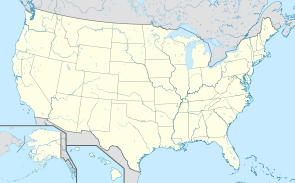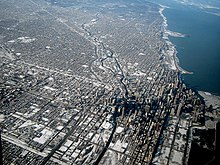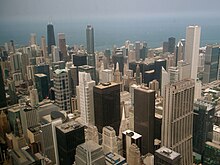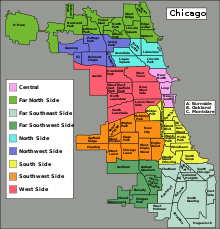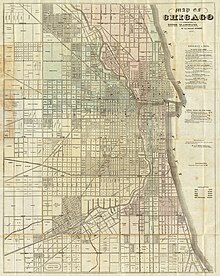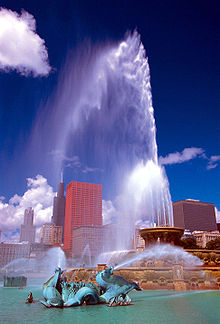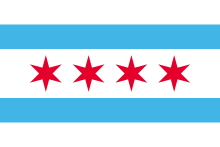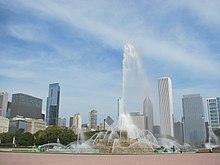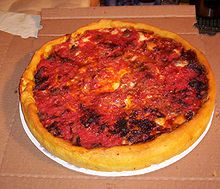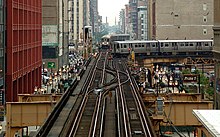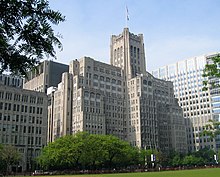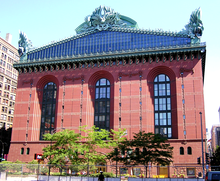Chicago
| Chicago | ||
|---|---|---|
| Nickname : The Windy City, Chi-City, Chi-Town | ||
 Top left to bottom right: Downtown Chicago, Willis Tower , Chicago Theater , the Chicago 'L' , Navy Pier , Field Museum of Natural History , Millennium Park |
||
 seal |
 flag |
|
| Location in Illinois | ||
|
|
||
| Basic data | ||
| Foundation : | August 12, 1833 | |
| State : | United States | |
| State : | Illinois | |
| Counties : |
Cook County DuPage County |
|
| Coordinates : | 41 ° 53 ′ N , 87 ° 38 ′ W | |
| Time zone : | Central ( UTC − 6 / −5 ) | |
|
Inhabitants : - Metropolitan Area : |
2,746,388 (as of 2020) 9,618,502 (as of 2020) |
|
| Population density : | 4,668 inhabitants per km 2 | |
| Area : | 606.1 km 2 (approx. 234 mi²) of which 588.3 km 2 (approx. 227 mi²) are land |
|
| Height : | 179 m | |
| Outline: |
 Location in the metropolitan area |
|
| Postcodes : | 60601-60827 | |
| Area code : | +1 312 (center), 773 (other areas) | |
| FIPS : | 17-14000 | |
| GNIS ID : | 423587 | |
| Website : | www.chicago.gov | |
| Mayor : | Lori Lightfoot ( D ) | |
 Satellite image |
||
Chicago on the map of the United States |
Chicago (rarely in German also Chikago , pronunciation: [ ʃɪˈkɑːgoʊ ]; ) is a city on the southwestern shore of Lake Michigan in the state of Illinois in the United States of America . With a population of 2,746,388, it is the third largest city in the United States . 8.7 million people live in the agglomeration and 9.7 million people in the metropolitan area of Chicago (2007).
Chicago has been a major trading city in the United States since the mid- 19th century . This function is favored by its property as a railroad junction and its location at the mouth of the Illinois Waterway . The city is located on important railroad lines connecting the east and west coasts and is connected to the Atlantic Ocean and New York City via the Great Lakes and the St. Lawrence Seaway and the Erie Canal . The Illinois Waterway connects to the Gulf of Mexico via the Mississippi .
Chicago is home to the Chicago Mercantile Exchange , the largest commodity futures exchange in the United States, and the Chicago Board of Trade , the largest commodities, futures, and options exchange in the United States. The largest regional exchange in the United States, the Chicago Stock Exchange, is also located here .
The Chicago metropolitan area generated an economic output of 651.2 billion US dollars in 2016. In a 2014 study, Chicago was ranked 9th among the economically strongest metropolitan areas in the world and 3rd in the United States.
Surname
The name shikaakwa derives from Miami-Illinois . It was originally part of the river name shikaakwa siipiiwi , now English Des Plaines River , which refers to the leek plant Allium tricoccum . In the Frenchized form Checagou it was first handed down to 1680 as a place name from the French explorer Robert de LaSalle . The plant is said to have been very widespread in this area in the 17th century.
The city's most popular nickname is Windy City . Its origins include strong winds from Lake Michigan , the supposedly boastful character of the city dwellers, and the rivalry with the city of Cincinnati .
geography
Geographical location
Chicago is in northeast Illinois . According to data from the United States Census Bureau, the city has an area of 606.1 square kilometers. Water bodies cover 2.94 percent (17.8 square kilometers) of this. In Chicago, the Chicago River once flowed into Lake Michigan , one of the five Great Lakes in North America . However, the direction of flow of the Chicago River was reversed in 1900, so that it no longer flows into Lake Michigan, which is used for drinking water, but is diverted into the Illinois River and ultimately into the Mississippi River via the Chicago Sanitary and Ship Canal . More than 20 drawbridges such as the State Street Bridge or the Canal Street Railroad Bridge span the river.
The Chicago metropolitan area covers an area of 28,163 square kilometers and extends over dozen of suburbs in nine different counties that are intertwined with the metropolitan area of Chicago. These are Cook , DuPage , Kane , Kendall , Lake , McHenry, and Will Counties in Illinois , Lake County in Indiana, and Kenosha County in Wisconsin . Since the suburbs are politically independent, no tax money flows out of these enclaves to finance the central infrastructure of the big city . This is particularly important for schools because a large part of their funding comes from local property taxes, with state-wide grants per student as a supplement.
The metropolitan area of Chicago was the inspiration for the development of the urban zone model of the renowned urban geographer Ernest Burgess around a Central Business District (CBD) . The so-called loop forms the core of the CBD ; this includes a neighborhood enclosed by the Chicago “L” tracks (Community Area 32) and the adjacent areas.
City structure
Since the urban area expansion in 1960 to enable the extensive expansion of O'Hare Airport , the City of Chicago has been divided into 77 community areas.
The center of the city is formed by the districts Chicago Loop (32), Near North Side (8) and Near South Side (33), which are separated from each other by the Chicago River. The AON Center, the Willis Tower and the City Hall are located in the loop . The heavily built-up part of Near North Side with high-rise buildings is essentially delimited by North Lake Shore Drive and North LaSalle Street . The tallest building on the Near North Side is the John Hancock Center . The world-famous inner skyscraper area covers about six square kilometers, that is only about one percent of the Chicago city area.
| 01 | Rogers Park | 21 | Avondale | 41 | Hyde Park | 61 | New City |
| 02 | West ridge | 22nd | Logan Square | 42 | Woodlawn | 62 | West Elsdon |
| 03 | Uptown | 23 | Humboldt Park | 43 | South Shore | 63 | Gage Park |
| 04 | Lincoln Square | 24 | West Town | 44 | Chatham | 64 | clearing |
| 05 | North Center | 25th | Austin | 45 | Avalon Park | 65 | West Lawn |
| 06 | Lakeview | 26th | West Garfield Park | 46 | South Chicago | 66 | Chicago Lawn |
| 07 | Lincoln Park | 27 | East Garfield Park | 47 | Burnside | 67 | West Englewood |
| 08 | Near North Side | 28 | Near West Side | 48 | Calumet Heights | 68 | Englewood |
| 09 | Edison Park | 29 | North Lawndale | 49 | Roseland | 69 | Greater Grand Crossing |
| 10 | Norwood Park | 30th | South Lawndale | 50 | Pullman | 70 | Ashburn |
| 11th | Jefferson Park | 31 | Lower West Side | 51 | South Deering | 71 | Auburn Gresham |
| 12th | Forest Glen | 32 | Chicago Loop | 52 | East side | 72 | Beverly |
| 13th | North Park | 33 | Near south side | 53 | West Pullman | 73 | Washington Heights |
| 14th | Albany Park | 34 | Armor Square | 54 | Riverdale | 74 | Mount Greenwood |
| 15th | Portage Park | 35 | Douglas | 55 | Hegewisch | 75 | Morgan Park |
| 16 | Irving Park | 36 | Oakland | 56 | Garfield Ridge | 76 | O'Hare |
| 17th | Dunning | 37 | Fuller Park | 57 | Archer Heights | 77 | Edgewater |
| 18th | Montclare | 38 | Grand Boulevard | 58 | Brighton Park | ||
| 19th | Belmont Cragin | 39 | Kenwood | 59 | McKinley Park | ||
| 20th | Hermosa | 40 | Washington Park | 60 | Bridgeport |
climate
Chicago's climate is continental ( Dfa ) with hot, humid summers and cold, snowy winters. The annual average temperature is 10.5 degrees Celsius, the annual rainfall 910 millimeters on average. The coldest month is January with an average of -3.3 degrees Celsius, the warmest month is July with an average of 24.3 degrees Celsius.
Most of the precipitation falls in August with an average of 107 millimeters, the least in February with an average of 35 millimeters. Overall, the weather in Chicago is changeable. A strong wind often blows, especially in spring and autumn, and there is high humidity all year round.
The highest temperature was officially recorded on July 24, 1934 at the weather station at Midway Airport as 41 degrees Celsius, the lowest on January 20, 1985 during the cold spell in North America at the weather station of the University of Chicago (Rosenwald Hall, 58th St. and University Ave.) with -33 degrees Celsius. Most of the precipitation fell on August 14, 1987 at the weather station at O'Hare Airport with 165 millimeters. The snowiest winter was 1978/79 (November 27th to March 4th) with 2278 millimeters of precipitation.
| Chicago | ||||||||||||||||||||||||||||||||||||||||||||||||
|---|---|---|---|---|---|---|---|---|---|---|---|---|---|---|---|---|---|---|---|---|---|---|---|---|---|---|---|---|---|---|---|---|---|---|---|---|---|---|---|---|---|---|---|---|---|---|---|---|
| Climate diagram | ||||||||||||||||||||||||||||||||||||||||||||||||
| ||||||||||||||||||||||||||||||||||||||||||||||||
|
Average monthly temperatures and rainfall for Chicago
Source: WMO: World Weather Information Service
|
|||||||||||||||||||||||||||||||||||||||||||||||||||||||||||||||||||||||||||||||||||||||||||||||||||||||||
story
Early history
The region of today's city was inhabited by Algonquian tribes such as the Mascoutes and the Miami . They had been driven westward by the Iroquois Wars of the 16th and 17th centuries, especially the Beaver Wars . However, they returned around 1700. Six groups belonged to the Miami at that time, the Atchatchakangouen (the actual Miami), Kilatika, Mengakonkia, Pepikokia, Piankashaw and Wea, of which a hundred years later only the Miami, the Piankashaw and the Wea remained. By 1720 they lived mostly in Indiana . The term shikaakwa (wild onion) comes from the Miami language .
They traded with their neighbors, the Potawatomi in the east, the Fox in the north, and the Illinois in the southwest, the latter of which had separated from the Miami shortly before the arrival of the first Europeans. They ruled Illinois and with it the area that would later become Chicago. Of the numerous villages that the first French registered in 1673, only Cahokia, Kaskaskia, Peoria, Michigamea, Moingwena and Tamaroa survived the epidemics that struck them. At the same time they left the Chicago area southwest. In 1673 they counted 12,000 people, in 1736 there were only 2,500. In 1725, “Chicago”, a Michigamea-Illinois chief, visited Paris . In 1800 the Illinois counted only 100, in 1833 the last family left the state. Jean Baptiste Ducoigne , a Kaskaskia Illinois chief and friend of President Thomas Jefferson , supported the United States in the uprising against Great Britain and in the War of 1812 .
From trading post to city (1673–1837)
In 1673 the French explorers Jacques Marquette and Louis Joliet explored the area of what is now Chicago, which the indigenous people living there called shikaakwa , or Frenchized Checagou . In the 1770s, Jean Baptiste Point du Sable , son of a Québec merchant and a black slave, set up a trading post at the exchange site for the local tribes of Miami , Meskwaki , Othâkîwa and Potawatomi . "The first white man who settled here was a black," they are quoted as saying.
Thanks to its convenient location on the waterways of Lake Michigan , one of the Great Lakes , and the Chicago River , the trading post gained noticeably in importance until the beginning of the 19th century. When Illinois joined the United States in 1818 and therefore needed better transport connections, Chicago quickly gained the reputation of being the “gateway to the west” after the east-west railroad was built. It was now the most important trading center for raw materials and agricultural products far and wide.
Wood came in ships from the north and was resold locally or transported by rail, and the farmers brought food to the markets, from where it could then be reloaded onto ships or trains and shipped. Tools and other materials that were initially not produced locally or in insufficient quantities came from the east. So the trading post became a village. On August 12, 1833, Chicago was officially founded and four years later, on March 4, 1837, with its 4200 inhabitants, it was elevated to the status of a city.
Rapid expansion (1837–1885)
More and more people moved to the city and the already strong trade continued, which attracted even more immigrants. Chicago's population rose from just 100 in 1830 to 100,000 by 1860. Land prices rose rapidly. When the construction of the “ Illinois and Michigan Canal ” between the Chicago River and the Illinois River, which flows into the Mississippi, began in 1836 and was completed in 1848, there was another extremely attractive transport route. Six states south along the Mississippi and three north and regions along the Missouri River , which flows into the Mississippi, were now also opened up by a wide waterway.
Also in 1848, the first railway line that also served Chicago was opened: the Galena and Chicago Union Railroad . Since the completion of the Chicago Sanitary Canals in 1900, the Chicago River no longer flows into Lake Michigan, but through the Illinois and Michigan Canal and subsequently the Illinois River into the Mississippi.
By 1850 Chicago already had 30,000 inhabitants, and there was no end to the influx in sight - the general conditions at the transportation hub of the United States were too favorable. In 1855 the Beer Riot camp was established . In this uprising, German settlers fought for their right to be able to serve beer on Sundays.
From 1856 the floor level of the entire center of Chicago was raised piece by piece to improve the sewerage system after various epidemics . The elevation took about 20 years, with elevations of less than a meter up to 2.5 meters.
Between October 8 and October 10, 1871, the Great Fire of Chicago raged , which destroyed most of the city. 125 bodies were recovered after the fire. In the end, estimates came to 300 deaths and 18,000 houses destroyed. About 100,000 people became homeless. Improved fire protection regulations were taken into account during the rapid reconstruction. Architects like Louis Sullivan and later also Frank Lloyd Wright came to the city, which now served as an experimental field for urban innovations. In 1880 the "reborn" city already had 500,000 inhabitants.
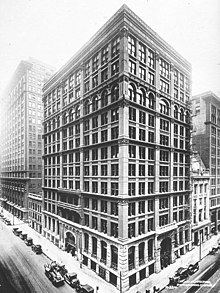
The population doubled between 1880 and 1890 and Chicago now had a population of over a million. Land prices in the city center have seen extreme increases since they were named city, but this time a new price dimension has been penetrated. A square meter cost 130 US dollars in 1880, but by 1890 the price increased sevenfold to almost 900 US dollars per square meter. In order to operate profitably, property owners began to use their floor space to the maximum - that is, it had to be built higher. Thanks to new inventions such as electric elevators, fireproof building materials, but above all through the use of steel frames in building construction, this became possible.
The Home Insurance Building , built in 1885 and demolished in 1931, was the first structure to combine the new technical achievements and, with its original ten floors and 42 meters high, is considered the first modern skyscraper in the world. The Auditorium Building , built in 1889 by Dankmar Adler and Louis Sullivan , also had an air conditioning system as a novelty , in addition to its almost perfect acoustics . The Reliance Building was built between 1890 and 1894 and is considered to be the forerunner of the glass curtain wall construction that would later determine the “international style”. It is considered a masterpiece of the Chicago First School.
Industrial great power (1885-1918)
On May 1, 1886, the Chicago unions organized a strike to reduce working hours from twelve hours a day to eight hours. When the police cracked down on May 3 and the strikers were killed, a riot broke out in what went down in history as the Haymarket Riot ; since then it has been commemorated annually on May 1st, Labor Day . Otherwise, the end of the 19th century was not a calm phase either. The corruption had its first heyday. Many of the city's politicians were for sale. About a quarter of the city council owned saloons and were considered boodlers ("smeared"). Hempstead Washburne , Mayor from 1891 to 1893, campaigned for his re-election, saying that it would be “wiser to vote for a man who has already stolen enough than for a new one”. Even electoral fraud was rampant. In any case, Washburne was unsuccessful in his re-election.
From 1 May to 30 October 1893, as was World's Columbian Exposition called World's Fair held in Chicago. She had a great influence on the development of art and architecture of the time. The event shaped Chicago's self-perception and strengthened the population in their optimistic view of industrial progress, especially since Chicago won the race against the unloved New York City .
In 1890 there were one million people in the city, and by 1910 that number had doubled to two million. In 1900 the city already had 1.7 million inhabitants, including many German , Irish and Eastern European immigrants. It was around this time that Chicago's reputation was cementing itself as a place of seemingly limitless opportunity, with numerous jobs waiting for anyone willing to work. Southern black residents were most drawn to this promise. Between 1916 and 1919 alone, between 50,000 and 75,000 African Americans moved to the city.
During this time Chicago was also known as the hog butcher for the world . The city was the main hub for the agricultural products of the Midwest, in addition to grain and wood, this was mainly cattle. The slaughterhouses on the so-called Union Stock Yards had developed into the most important in the world within a few decades. Assembly line production in meat processing in particular was trend-setting worldwide. At the turn of the century, up to 12 million animals were slaughtered annually in the stock yards and around 82 percent of American meat was processed. The poor working conditions and poor hygiene became known, among other things, from Upton Sinclair's novel The Jungle .
Long working hours, low wages and inhumane working conditions, but above all the traditions of self-organization brought with them by the immigrants, made Chicago the cradle of the American trade union movement . By 1900 most of the workers had organized themselves into the American Federation of Labor. The revolutionary union Industrial Workers of the World (IWW), which still exists today , was founded here in 1905. The play Saint Joan of the Stockyards by Bertolt Brecht plays in Chicago in the late 1920s and on the other hand focuses on the poor working conditions and the workers' struggle. When on July 27, 1919 a white policeman refused to arrest an accused white boy after stoning a black youth swimming in the lake, a six-day uprising followed with 38 dead.
City of jazz and gangsters (1918–1945)
From 1922 Chicago became a jazz metropolis . Big names such as Louis Armstrong , Earl Hines and Jelly Roll Morton enlivened the “black clubs” and shaped Chicago jazz . In that year, the Tin Pan Alley composer Fred Fisher, who emigrated from Cologne to Chicago, wrote Chicago (That Toddling Town), a much-covered homage to the city.
Not only jazz came to Chicago through the Afro-Americans: The city also became a center of black organizations - both the PUSH (People United to Save Humanity) founded by Reverend Jesse Jackson and the more militant “ Nation of Islam ” (actually “The Lost- Found Nation of Islam ", also known as" Black Muslims "), founded by Elijah Muhammad in 1930, have their headquarters on the South Side in Chicago.
During the Roaring Twenties , criminal syndicates among unscrupulous gang bosses like Bugs Moran , Johnny Torrio and Al Capone took advantage of prohibition and sold illegally produced alcohol. Gun fights between police and gangsters weren't as common as many films would have you believe, but the mafia-like system worked.
In 1933 and 1934, under the motto A Century of Progress, a world exhibition took place in Chicago for the second time , to which the German airship LZ 127 made a visiting trip in 1933.
On October 5, 1937, the US President Franklin D. Roosevelt held his worldwide sensational " quarantine speech " in the city on the occasion of the inauguration of the Outer Link Bridge on Lake Shore Drive , in which for the first time the right of the USA to have a say in the future political order of the world was raised.
In 1942, physicist Enrico Fermi at the University of Chicago managed the first controlled nuclear chain reaction as part of the Manhattan Project , the aim of which was to build nuclear weapons .
Downturn and recovery (from 1945 to the end of the 20th century)
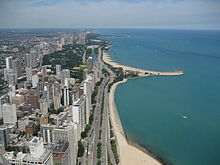

The population reached its maximum in 1950 (3.62 million inhabitants); thereafter, due to the (mostly white) middle class migrating to the suburbs, it steadily declined by a total of around 840,000 inhabitants until 1990. Since the beginning of the 1990s, the population has recovered.
From 1955 to 1976 Richard J. Daley, as mayor, had a major influence on politics in Chicago; He also played an important role in the Democratic Party , for example in supporting the presidential candidacies of John F. Kennedy in 1960 and Hubert Humphrey in 1968. During his reign, the brutal crackdown on antiwar demonstrators fell in 1968. During the Democratic National Convention in August 1968 it came to an end violent riots against the Vietnam War . In 1969 the Chicago Seven were charged for this.
In 1979 Jane Byrne became Chicago's first female mayor and Harold Washington became first black mayor in 1983 . The challenger to the Democrat Washington in the 1983 mayoral election was Republican Bernard Epton, who was supported by many white Democrats and grassroots organizations. Epton received 90 percent of all votes in the boroughs with a predominantly white population and only 3 percent in those with a predominantly black population. At Washington, the numbers were reversed. Overall, Harold Washington won by four percentage points. He won the re-election in the spring of 1987 with certainty. He ruled Chicago until his death in November 1987.
Center of the region (21st century)
The city's status as the region's cultural and economic center has been undisputed since the beginning of the 21st century. The city is also faced with a high number of gunshot victims. In 2016 there were around 4,300 people shot, of which around 760 died.
Demographics

In 2008, 2,853,114 people lived in the city. That was a decrease of 1.8 percent compared to 2000. The Chicago metropolitan area , also known as “Chicagoland”, was in 2008 with 9.5 million inhabitants in 30th position on the list of the largest metropolitan areas in the world .
According to the 2000 census , there were 2,896,016 residents, 1,061,928 households, and 632,909 families in the city area. The population density was 4,923 people per square kilometer. The population was 41.97 percent white and 36.77 percent African American; 4.35 percent were of Asian origin. 28.9 percent of the population were Hispanic (some of whom indicated their " race " as "white" in the census). The median income per household was 38,625 US dollars , the median income of a family at 42,724 US dollars. 19.6 percent of the population lived below the poverty line. The largest groups by ethnic origin in the urban area were: Poles 210,421 (7.3 percent), Irish 191,998 (6.6 percent), Germans 189,618 (6.5 percent), Italians 101,903 (3.5 percent) and English 57,579 (2nd , 0 percent).
Ethnic origin becomes less important for future generations, especially for children from mixed marriages. This also applies to the numerous descendants of German immigrants who live in and around Chicago. Since many residents are of Irish descent , there is a huge Saint Patrick's Day parade every March . To celebrate this day, the Chicago River is also colored green. Currently there is also a very large area in the northwest of the city, which is noticeable by the fact that the signs on shops are written in Korean. The relatively high number of Americans of Polish descent is also noticeable. Almost one million people of Polish origin live in the entire metropolitan area of Chicago. The constitution of May 3, 1791 is still commemorated annually as part of the Polish Constitution Day Parade and the Polish National Day is celebrated.
The following overview shows the population of the actual city according to the respective territorial status. 1830-2000 is census results and 2005 is an estimate from the United States Census Bureau .
|
|
politics
City government
The head of the city council of Chicago is the Mayor , who is elected by the population for a term of four years. He appoints heads of the various departments of the city administration and other civil servants. In some cases, city council approval is required. The mayor has the right to veto regulations .
The City Council consists of 50 members and is also elected every four years. She represents the different districts of Chicago. The city council passes laws, sets the property tax and allocates the financial resources to the individual departments of the city administration.
Chicago has long been a Democratic Party stronghold . The Democrats have been the mayor of Chicago without interruption since 1931. Current incumbent Lori Lightfoot took up her post on May 20, 2019.
flag
The flag of Chicago consists of two light blue horizontal stripes on a white field. The resulting three white stripes represent the north, west and south sides of the city. The upper blue stripe represents Lake Michigan and the northern arm of the Chicago River . The lower blue stripe represents the southern arm of the Chicago River and the great canal. The original 1917 design included just two red stars symbolizing the Great Chicago Fire of 1871 and the 1893 World's Columbian Exposition . In 1933 a third star was added for the ongoing World's Fair A Century of Progress and in 1939 a fourth star was added for Fort Dearborn . The addition of a fifth star has already been proposed several times, most recently in the event that the city had been awarded the capacity to host the 2016 Summer Olympics .
Town twinning
Chicago has 28 sister cities with which it is partnered. Most are in Europe (14), followed by eight in Asia and three in Africa . In America , Chicago has three partnerships. There are no twin cities in Australia .
|
|
Culture and sights
In a ranking of cities according to their quality of life, Chicago took 49th place out of 231 cities worldwide in 2019. The city was behind San Francisco (34th place) or New York City (44th place) but still ahead of Washington, DC (53rd place), Dallas (63rd place), Los Angeles (66th place) or Detroit (72nd place).
theatre
Chicago has a significant theater culture. A total of 250 professional ensembles are based in Chicago, and there are 115 venues with a total of 64,000 seats. A highlight in the city's theater scene is the Chicago Theater Week, which takes place in February, with more than 100 productions at around several dozen venues.
The city is considered the birthplace of modern improvisational theater . The student drama group The Compass , founded in 1955, revived the principles of the Commedia dell'arte and - inspired by Bertolt Brecht's theater theories - performed socially critical, satirical improvisations according to so-called scenarios. In addition, short scenes were improvised according to the audience's instructions.
The Auditorium Theater , built in 1889, is located on South Michigan Avenue . It was founded by a few committed Chicago citizens to give the city a cultured image with this building, richly decorated with gold, mosaics and murals.
The Biograph Theater is on Lincoln Avenue . On July 22, 1934, John Dillinger was surrounded by FBI agents and shot there after a friend of his lover, the legendary Woman in Red ( Anna Sage ), had given them a tip. Other well-known theaters are the Court Theater, the Goodman Theater and the Merle Reskin Theater (former Blackstone Theater).
On December 30, 1903, 602 people died in a fire in the Iroquois Theater . The accident led to the introduction of strict fire-fighting guidelines across the country. The building reopened as the Colonial Theater a year later and was demolished in 1925. The Oriental Theater was built in its place in 1926 .
The Second City is a theater company based in Chicago. It is the best-known theater company based in the city outside of Chicago. Numerous former members later appeared on the television comedy show Saturday Night Live . Well-known former members include: Alan Alda , Ed Asner , Dan Aykroyd , John Belushi , Bonnie Hunt , Bill Murray and Mike Nichols .
The Steppenwolf Theater Company , founded among others by Gary Sinise and named after the novel of the same name by Hermann Hesse , also enjoys a nationwide reputation . From this theater company a number of Hollywood celebrities emerged over the course of time (in addition to Sinise and Malkovich e.g. Joan Allen , John Mahoney , Martha Plimpton , Glenne Headly , Nick Offerman , Gary Cole , Terry Kinney , Kathryn Erbe , Laurie Metcalf , Kevin Anderson , Ethan Hawke , Jim True-Frost and William Petersen ).
The Lyric Opera of Chicago (LOC), founded in 1954, is one of the leading opera houses in the United States. The opening season in which Maria Callas made her American debut in Norma is legendary . The Lyric Opera takes place in the Civic Opera House, the second largest opera theater in the United States.
Museums
The numerous important museums in the city include the Adler Planetarium and Astronomy Museum, which was completed in 1930 . It shows numerous exhibits on the subject of space, the planetary system and their historical and current exploration on several levels. The collection of historical instruments is world famous. In addition, it has two theaters for astronomical presentations, one with a Zeiss projector and one with a modern digital laser show, which in particular enables flight simulations.
The Art Institute of Chicago is an art museum and art college founded in 1866. It displays treasures and masterpieces from around the world, including in particular Impressionist , Post-Impressionist, and American art. Well-known works such as Claude Monet's Haystack , Georges Seurat's A Sunday Afternoon on La Grande Jatte Island , Grant Woods American Gothic and Edward Hopper's Nighthawks can be seen in the museum . It also houses the life's work of photographer Irving Penn .
The Field Museum of Natural History was founded in 1893 as the Columbian Museum of Chicago . After initially even art was one of his areas of collection, with the renaming in 1905 the focus was on natural sciences and ethnology. The namesake Marshall Field ensured that the foundation's assets are still significant today. In 1921 the current house on the shores of Lake Michigan could be moved into. The Field Museum houses more than 30 million preserved organisms and other collectibles. In this sector too, it is one of the largest scientific and anthropological collections in the world.
The Museum of Contemporary Art (MCA) is a museum for contemporary art founded in 1967. The MCA was the first project by the German architect Josef Paul Kleihues in the United States. It includes a large number of interactive exhibits and video presentations, as well as a section with works by Alexander Calder , Andy Warhol, and others; at the rear there is a sculpture garden and a patio .
The Museum of Science and Industry is a science center and is located in Jackson Park , just south of downtown Chicago. The museum building was built in 1893 for the World's Columbian Exposition and is the only remaining building at this world exposition. According to Rosenwald's ideas, many exhibitions were designed to be interactive. This concept has been retained to this day. For example, visitors can walk through a model of the human heart, learn the history of the telephone in the Hall of Communications , or visit a replica coal mine .
One of the most magnificent mansions in downtown Chicago, the Nickerson House at 40 East Erie Street, the Richard H. Driehaus Museum houses a valuable private art collection and original furnishings from the late 19th century that are well worth seeing.
The Chinese American Museum of Chicago , which opened in 2005, was renovated after a fire and reopened in 2010.
The newest museum is the American Writers Museum at 180 North Michigan Avenue, the first museum in the United States dedicated to the history of American writers.
music
The city played an important role in the further development of the genuinely American musical styles of jazz , blues and soul . As a result of a large economic migration at the beginning of the 1920s and the closure of the Storyville entertainment district in New Orleans , the musical center of jazz increasingly shifted to Chicago.
Important musicians such as Louis Armstrong , King Oliver and Jelly Roll Morton worked in the city. A brisk jazz life developed in the Southside, the black district of the city. The so-called Chicago jazz developed , which placed solo improvisation more in the foreground than collective improvisation, and tended to be more cool in playing.
The rural Delta Blues, shaped by guitar and harmonica, was electrified in Chicago. The so-called Chicago Blues emerged . The city became an active center of the blues to this day, shaped by musicians such as Howlin 'Wolf , Muddy Waters , Little Walter and Willie Dixon . Chicago soul developed in the 1960s, with Curtis Mayfield as its best-known representative . The city is considered the birthplace of house music with its sub-genre Chicago House . The RnB artist R. Kelly comes from Chicago and often references this city in his music.
Also in the hip-hop -music Chicago in recent years thanks to rappers like Common , Lupe Fiasco , Twista and the rapper, songwriter and producer Kanye West has become an influential city.
The Chicago Symphony Orchestra is one of the best orchestras in the United States. It performs in the Chicago Orchestra Hall (sometimes named Theodore Thomas Orchestra Hall after the orchestra's founder). The complex, built in 1904, was radically rebuilt in 1966, so that the extraordinarily round sound was lost. Due to the now dry and narrow soundscape, the sound recordings were mostly made elsewhere, especially in the Medinah Temple. In 1997 a renewed renovation phase ended, one of the aims of which was to restore the old soundscape. The sound actually gained audibly in breadth and beauty, only the musicians now complained that they could no longer hear each other. A bearable state has now been achieved through various improvements.
The Association for the Advancement of Creative Musicians (AACM) is an association of jazz musicians who are committed to the renewal of African-American music and who are also active in music education in numerous schools in Chicago.
The Warehouse disco, which existed from 1977 to 1982, is considered the birthplace of house music.
Other well-known musicians and bands in the city are: the Art Ensemble of Chicago ("Great Black Music, Ancient to the Future"; it had a style-forming effect on the area of ethnically influenced jazz music), the band Chicago , the rock band Chevelle ("second At home “of jazz, blues) as well as the blues band The Blues Brothers , the alternative rock band The Smashing Pumpkins , the melodic hardcore band Rise Against , the former synth-pop and now industrial metal band Ministry and the Independent -Band Wilco .
Major music festivals in Chicago include Lollapalooza in Grant Park, the Taste of Chicago in July (with a festival character), the Chicago Blues Festival over three days in June, and the Chicago Jazz Festival on Labor Day weekend.
Literary affairs
Around the time of the First World War , Chicago became a center of cultural creativity, particularly in the field of literature. The focal point of this movement was the literary journal Poetry : A Magazine of Verse, founded in 1912 . At this time Edgar Lee Masters ( Spoon River Anthology 1915) and Carl Sandburg emerged with works that dealt in depth with Illinois and Chicago. Other Chicago writers who took on their city and culture included Eugene Field, George Ade, Henry Blake Fuller, Hamlin Garland , Robert Herrick, and William Vaughn Moody.
The authors Theodore Dreiser , Nicholas Vachel Lindsay and Ring Lardner stood out from them with a pointed, mocking style. Most famous, however, was Upton Sinclair with his socially critical books, especially about the slaughterhouses in Chicago. He thus had a great influence on European literature and, above all, on writers who were close to the labor movement, such as Bertolt Brecht . However, Sinclair only lived temporarily in Chicago. Later famous writers in the city were James T. Farrell , Richard Wright , Nelson Algren , Gwendolyn Brooks and Saul Bellow . The crime writer Sara Paretsky has her detective V. I. Warshawski investigated regularly in Chicago.
Buildings
The tallest buildings

Downtown Chicago is a collection of modern architecture. This starts with the typical skyscrapers around 1900 and leads to the masterpieces of Ludwig Mies van der Rohe or the Lake Point Tower (the world's tallest apartment building when completed in 1968) to the Willis Tower , which was completed in 1974 . Chicago is also considered the birthplace of skyscrapers, as the ten-story Home Insurance Building was the first steel-framed house to be built here in 1885.
Chicago's tallest building is located at 233 South Wacker Drive, the 442-meter-high Willis Tower (formerly Sears Tower). At this height, until the One World Trade Center in New York City was completed in 2013 with 541 meters, it was the tallest skyscraper in the United States . With antennas, the structure measures 527 meters, making it the twelfth-tallest free-standing structure on earth . On the 103rd floor, the Willis Tower includes a 412 meter high viewing platform including glass balconies on the outer facade.
The second tallest building in Chicago is the 423 meter high Trump International Hotel and Tower , which only opened in 2009 (357 meters to the roof, the top counts towards the height). Other tall buildings are the Aon Center with 346 meters and the 344 meters high John Hancock Center (with antennas even 457 meters).
Chicago still has some buildings around 280 meters high, for example the AT&T Corporate Center (307 meters, completed in 1989), Two Prudential Plaza (303 meters, 1990), 311 South Wacker Drive (293 meters, 1990), 900 North Michigan (265 meters) , 5 meters, 1989) and Water Tower Place (262 meters, 1976).
In 2007, construction began on the 610-meter-high Chicago Spire on the shores of Lake Michigan. At the end of 2008, construction work on the tower ceased and there are no signs of resumption or completion.
Other structures
The compact center is called The Loop , because it is surrounded by the "El" called elevated railway of the urban transport company CTA . Here in the business center is the Art Deco high-rise of the Chicago Board of Trade , where half of the world's wheat and corn crops are traded, and the Chicago Mercantile Exchange . Precious metals, movable and immovable goods valued at approximately $ 50 billion a day are traded there.
There are some buildings worth seeing in the vicinity. The Rookery , 209 South LaSalle Street, built in 1886 by Daniel Hudson Burnham and John Wellborn Root, is one of the city's most famous and most photographed structures. The Moorish - Gothic exterior does not suggest that there is a light-flooded entrance hall inside. A spiral, cantilevered cantilever staircase leads up from the second floor. Nearby is the Continental Illinois Bank , adorned with 28 Ionic marble columns and murals.
The Reliance Building at 32 North State Street looks like it was built during the Art Deco period in the 1930s, but it was completed in 1895 to a design by Daniel Burham. Burham definitely determined the face of Chicago; his Fisher Building with maritime- inspired terracotta figures is at 343 South Dearborn Street. One block further south is the Manhattan Building by William LeBaron Jenney from 1890, the first 16-story building. From here, along the west bank of the river, stretches a revitalized stretch of promenade with street cafes and parks.
One of Chicago's oldest buildings stands on North Michigan Avenue , the Chicago Water Tower , built in 1869 . The limestone building, reminiscent of a 13th century castle, is a landmark of the city and is now home to Chicago's tourist information office. The stone castle is surmounted by a 30 meter high tower. Across the street is the associated pump station . Both are among the few buildings that survived the Great Fire of 1871 . Just a few steps from the Old Water Tower is the Water Tower campus of the Catholic Loyola University Chicago . It houses the departments for business administration and law .
Even Ludwig Mies van der Rohe shaped the architecture of the city. On the banks of the Chicago River there is a building that is widely regarded as his masterpiece, the IBM Building from 1971. Countless architects around the world have orientated themselves on its soft play of light and shadow between bronze and smoked glass. Other buildings by Mies van der Rohe include the Lake Shore Drive Apartments (two identical towers with steel frame construction on the outside), the Federal Center (three buildings with a large plaza and red sculpture) and several buildings for the Illinois Institute of Technology , such as the Crown Hall , a combination of steel and glass.
Frank Lloyd Wright is known for his so-called prairie houses. Many of these houses were built outside of Chicago, but one is also within the city limits , Robie House , built between 1907 and 1909 on the University of Chicago campus . Extensive roofs, horizontal ribbon windows and a free floor plan around a centrally located chimney are typical of these free-standing buildings.
According to Helmut Jahn's plans, the State of Illinois Center was built between 1979 and 1983 . The 94 meter high government building made of granite and steel houses offices, shops, restaurants and galleries around the central rotunda . On May 10, 1993, it was named after former Governor James Thompson.
Also worth seeing are the Wrigley Building (built on behalf of the Wrigley chewing gum company of the same name ), the Tribune Tower , the Green Mill (favorite bar of gangster Al Capone , still decorated in the style of the 1920s), the Drake Hotel, which opened in Lincoln Park in 1920, and the twin towers of Marina City , which later served as a template for the Augsburg hotel tower . In Old Town, west of LaSalle Street, is St Michaels Church , built in 1873 . It originally formed the center of a German community. Today people from different countries of origin live there.
Located at 925 on South Homan Avenue is the historic Sears, Roebuck and Company Complex , listed on June 2, 1978 on the National Register of Historic Places with number 78001129. The complex is also inscribed on the National Historic Landmark .
In the center of the city is the Al-Sadiq Mosque , built in 1922 .
The historic Chicago Club is located at 81 East Van Buren Street . On West Van Buren Street, on the other hand, is the historic United States Post Office at number 433.
The historic John J. Glessner House is located at 1800 on South Prairie Avenue (NRHP 70000233). The building is the work of architect Henry Hobson Richardson .
The historic hospital named after Mary Harris Thompson (1829–1895) existed from 1865 to 1988.
Parks
Grant Park extends east of the Art Institute to Lake Michigan and is criss-crossed by highways and railroad tracks. In the center of the northern half of the park is the Clarence Buckingham Memorial Fountain and Garden (designed by Marcel Francois Loyau ), where the light and water shows are held daily from sunset to 11 p.m. Almost every weekend a music festival is held in the area around the Petrillo Music Shell, right behind the Art Institute, be it gospel, blues, country, jazz or classical music. The biggest sights are concentrated around the newly landscaped southern half of Grant Park, the so-called Museum Campus.
South of the Art Institute is the marble-clad Greek temple designed by Daniel Burham that houses the Field Museum of Natural History . On the opposite side of the busy Lake Shore Drive, on the shores of Lake Michigan, is the Shedd Aquarium , one of the largest covered aquariums in the world. The attached Oceanum forms an enormous contrast to the aquarium. The facility is intended to represent a rocky coast in Alaska - an elaborate staging in which the "natural behavior" of the animals is demonstrated.
The Lincoln Park Zoo is also located in Lincoln Park, a vast expanse of greenery in Chicago. Inland from Lake Michigan is the Lincoln Park neighborhood: it is concentrated along Lincoln Avenue and Clark Street. Halsted Street, on which there are many blues bars and nightclubs, runs in a north-south direction through the middle of the district.
Millennium Park, opened in 2004 on the shores of Lake Michigan, is the first cultural institution in the United States to offer audio tours in digital MP3 format. The Jay Pritzker music pavilion with its outstanding acoustics and the pedestrian bridge were designed by the architect Frank Gehry . At the Crown Fountain by Jaume Plensa , the water flows down two glass towers accompanied by changing video and light effects. In 2006 the sculpture Cloud Gate was created by the Indian sculptor Anish Kapoor . The 110-ton stainless steel structure reflects the skyline of Chicago's Loop.
The Brookfield Zoo is a zoo in Brookfield, a suburb of Chicago. It occupies an area of 57.4 hectares. The animal population includes 3100 animals from 450 species. The zoo opened its gates on July 1, 1934 and quickly gained international recognition because, instead of many bars, it used generous gorges and moats to separate the animals from the visitors. The zoo was also the first in the United States to display giant pandas , one of which was prepared and given to the Field Museum of Natural History in Chicago.
Sports


A well-known team in the city are the Chicago Bears , an American football team that plays in the National Football League (NFL), the most important American professional league. The team was founded in 1920 as Decatur Staleys and is one of the founding members of the American Professional Football Association (APFA), founded in 1920 and renamed the NFL in 1922. The Bears currently play in the league in the National Football Conference (NFC), in the North Division . In the first decades of the NFL, the Bears were one of the dominant teams in the league, winning eight championships . In 1986 they last won the Super Bowl . Their home is Soldier Field .
The Chicago Blackhawks are an ice hockey team in the National Hockey League . The team was founded in 1926 and is one of the original Six teams in the NHL. You have won the Stanley Cup six times so far, most recently in 2014/15 . The home games are played in the United Center . The club colors are red, white and black.
The Chicago Bulls are part of the American professional basketball league NBA . The team plays its home games at the United Center . Due to their successes in the 1990s, the Bulls are among the world's most famous teams in the NBA. Since 2006, Chicago Sky has also played a team in the WNBA . They play their home games in the UIC Pavilion.
The Chicago Cubs are a baseball team. You play in the Central Division of the National League . The Chicago Cubs were founded in 1870. The team plays their home games at Wrigley Field . In the first decades of the National League, the Cubs were among the dominant teams in the league. They won the World Series in 1907 and 1908. In the period after the First World War, however, they never regained their former strength. It was only after 108 years that the Cubs were able to win the 2016 World Series against the Cleveland Indians .
The Chicago White Sox are a major league baseball team in the American League . The club plays its home games in US Cellular Field ( New Comiskey Park until 2003 ). The first All-Star Game of Major League Baseball took place there on July 6, 1933, winning the American League 4-2. The White Sox are three-time World Series winners (1906, 1917 and 2005).
Chicago Fire is a franchise of professional soccer league Major League Soccer (MLS). In their first season in 1998, they won the MLS Cup . They also won the US Open Cup in 1998, 2000, 2003 and 2006 . The venue is the SeatGeek Stadium (until 2018 Toyota Park ) in Bridgeview .
The Chicago Wolves are an ice hockey team in the American Hockey League (AHL). Their home stadium is the Allstate Arena in Rosemont near Chicago, which can seat 16,700 people. The club was founded in 1994. In 2001 they rose from the International Hockey League (IHL) to the AHL. In the IHL they won the Turner Cup in 1998 and 2000 and in the AHL in 2002 and 2008 the Calder Cup .
The Chicago Marathon has been held every October since 1977 . It is one of the largest marathon events in the world and one of the five World Marathon Majors .
Chicago was chosen on April 14, 2007 as the city of the United States to host the 2016 Summer Olympics , but could not prevail in the award. The 1959 Pan American Games were held in Chicago . In addition, the 1904 Summer Olympics were initially awarded to Chicago. However, the American government asked to move to St. Louis , because the world exhibition was taking place there and the city was celebrating its 100th anniversary.
The Chicagoland Speedway is located south of downtown just off Illinois Route 53 between Joliet and Wilmington. The audience capacity is 75,000. Since opening in 2001, it has become an unexpected draw for NASCAR and Indy Racing League events, where tickets are often sold out months in advance.
Regular events
Spring and summer
The Ravinia Festival, an open air festival, lasts three months. More than 100 events and concerts - from classical to pop - are held in Highland Park. At the Great Chicago Places and Spaces , the city of Chicago shows its successes in the fields of architecture, urban design as well as landscape and environmental planning. The Gospel Music Festival features gospel performances by major artists from around the country in Grant Park . The Printer's Row Book Fair brings together authors, poets, booksellers and readers from the American Midwest . The Gold Coast Art Fair in the Gold Coast district is the meeting place for hundreds of artists and art lovers from all over the world.
Dozens of blues musicians perform in Grant Park at the four-day Chicago Blues Festival in June . Old Town Art Fair is one of the oldest and most sophisticated art markets in the country. Taste of Chicago is a culinary festival of many restaurants in the city. The Venetian Night Parade presents Chicago's themed boats on the lakeshore with matching music and fireworks at the end. The Air & Water Show features performances by the world's best military and civil pilots on the beach. The Chicago Jazz Festival in Grant Park takes place in September on Labor Day with numerous jazz artists.
autumn and winter
At the Chicago Celtic Festival pictures, glass, clothes, ceramics and jewelry from national and international artisans are exhibited and sold. Each October, around a million people watch the runners in the Chicago Marathon . The Chicago International Film Festival is one of the oldest film events in North America and has been held every October since 1965. The Gold Hugo is awarded as the main prize . The State Street Thanksgiving Parade displays decorated floats and balloons. At the Magnificent Mile Lights Festival in November, the Magnificent Mile is transformed into a winter landscape.
At the Christkindlmarket , tree decorations, toys, nutcrackers and glassware from Europe are sold in wooden stalls and tents on Daley Plaza. The Chicago Boat, RV and Outdoors Show features hundreds of boats and RVs. The Chicago Auto Show presents the latest car models in February. The Chicago Flower and Garden Show is a garden-themed exhibition. On Saint Patrick's Day , a grand parade is held annually on March 17th in honor of the Irish national saint, St. Patrick .
gastronomy
Chicago is home to numerous restaurants serving international cuisine. Italian cuisine is right at the top, from deep-dish pizzas (created in 1953 at Pizzeria Uno, 29 East Ohio Street) to trattorias. Thai restaurants and Mediterranean eateries are also popular. There are also many Eastern European, German, Mexican, Chinese, Indian and also Burmese and Ethiopian cuisines.
In numerous restaurants, guests are served grilled ribs , a legacy from the time when Chicago was the “meat bank of the nation”. Most restaurants are to the west and north of the Loop, for example in Greek Town, around Halsted Street and Jackson Boulevard, and in Little Italy , Taylor Street and the surrounding area. There are numerous fine eateries in Near North and River North, and Cantonese and Sichuan cuisine in Chinatown.
After New York and San Francisco, Chicago is the third American city for which the Michelin Guide has published a city edition. Since the first edition in 2010, the Alinea has been the only restaurant that has since held its three-star rating.
business
overview
Chicago is an important industrial location and exhibition center as well as the seat of numerous corporations and associations. The manufacture of electronic devices, machine and vehicle construction, the processing of foodstuffs, the printing industry and the manufacture of precision instruments, steel, metal goods, textiles and chemical products are of importance. The port serves the export of oil, iron ore, coal, chemical products, textiles and grain. Motor vehicles, steel, fish and fish products as well as alcoholic beverages are imported.
While it was once Canadian wood that came to Chicago via the Great Lakes and from there was distributed among other things for the development of the west, it was later agricultural products and cattle, which from the end of the 19th century due to ever better development of the west and south were brought to Chicago by rail in ever larger quantities, and were traded there.
The Chicago Board of Trade was founded as early as 1848 , on which the largely agricultural raw materials as well as futures and options have been traded ever since . In 1898 the "Chicago Butter and Egg Board" was opened, today's Chicago Mercantile Exchange , the largest commodity futures exchange in the United States. In a ranking of the most important financial centers worldwide, Chicago ranks 14th (as of 2018).
Unemployment in Chicago has been well above the national average in the United States since 1990. The official unemployment rate in the city was 9.0 percent (US 5.6 percent) in 1990, then fell to 5.5 percent (US 4.0 percent) by 2000 and rose again to 8.2 percent by 2002 (USA 5.8 percent). By 2006 the rate fell to 5.2 percent (USA 4.6 percent). In May 2018 the unemployment rate was 3.3 percent (US 3.9 percent).
Numerous global corporations have their headquarters in Chicago: Boeing (one of the world's largest manufacturers of civil and military aircraft and helicopters as well as military and space technology), Encyclopædia Britannica Inc. (encyclopedia), Hyatt (one of the world's largest hotel chains), Midway Games ( Game developer), Playboy Enterprises (media company), Tribune Company (media company), McDermott Will & Emery (global law firm) and Wm. Wrigley Jr. Company (the world's largest manufacturer of chewing gum). The American headquarters of the German Siemens concern or its division the Building Technology Group is also based in Chicago (Buffalo Grove).
retail trade
Aside from high-rise office buildings, the loop also includes some must-see department stores from around 1900, such as the Carson Pirie Scott department store at 1 South State Street, designed by Louis Sullivan in 1899 . Two blocks north on the corner of State Street and Washington Street is the comparatively simple Marshall Fields, one of the oldest and largest department stores in the world.
Some department stores can be entered directly from North Michigan Avenue - also known as the Magnificent Mile - and many are located within large shopping centers. The oldest is Water Tower Place at 835 North Michigan Avenue, with more than 100 stores on seven floors and a busy food court . 900 North Michigan Avenue is more spacious and also houses somewhat more sophisticated shops, including Bloomingdale’s , Gucci and Aquascutum .
Also in the North Michigan Avenue that offers furniture and store Crate & Barrel international household goods, furniture and home accessories. Dozens of boutiques selling Giorgio Armani , Prada , Hino & Malee, and Sonia Rykiel are on Oak Street, a block from North Michigan Avenue. The Holiday Hospitality Center is located in the foyer of the Chicago Theater .
One of the world's largest shopping centers is in Schaumburg , outside of Chicago. The Woodfield Mall with its 285 shops is visited annually by about 27 million people; Although it can be reached by public transport from downtown Chicago, which is 50 km away, a different public transport authority (PACE) is responsible for the suburbs than for within the city (CTA). Also not in Chicago, but in Gurnee , is the Gurnee Mills shopping center , where you can buy goods from the factory at reduced prices. Shops from over 200 brand manufacturers are housed in the building. The VAT revenue from these two large shopping centers does not benefit the city of Chicago, but remains in the comparatively affluent suburbs. The city of Chicago also has no influence on the building permits and city planning decisions that are responsible for these off-center offers, even if this cannibalizes the demand in the inner-city branches of the department stores.
traffic
Long-distance transport
Highways
The city is connected to all parts of the country by highways. However, the vehicles on the expressways to and from the city center are usually stuck in traffic during rush hour.
The Interstate 55 , from Louisiana on St. Louis comes to Chicago, encounters in the city center on the US Highway 41 (Lake Shore Drive) next to McCormick Place to. In the Chicago metropolitan area , it is called the Adlai E. Stevenson Expressway in honor of an important Illinois politician. The section between Chicago and St. Louis runs parallel to or on the route of the former Route 66 .
The Interstate 57 leads from the southern end of the Dan Ryan Expressway in Chicago, where she Interstate 94 leaves, about Champaign (Illinois) and Cairo (Illinois) for the place Miner in southeastern Missouri where it meets Interstate 55 '.
The Interstate 90 (Seattle-Boston) and the Interstate 94 (Montana Minneapolis Detroit Canada) pass through Chicago.
Rail transport
With several marshalling yards, the city is the largest railway junction in the world. With the decline in the number of people in the course of the 20th century, most of the former six long-distance train stations disappeared from the image of the city. Although some of them are still used for suburban traffic, only Union Station has survived in a reduced form for long-distance traffic ; this is served by Amtrak . The Union Station is still the starting point for several transcontinental long-distance trains, including the Empire Builder to Seattle with through coaches to Portland (Oregon) , the California Zephyr to San Francisco / Emeryville, the Southwest Chief via Albuquerque to Los Angeles and Texas Eagle via San Antonio to Los Angeles. Chicago is also the hub of Amtrak's "Midwest" network.
The Belt Railway of Chicago (BRC), the largest shunting railroad company in the United States, was founded in the city in 1882. It operates a distance of 45 km and tracks totaling 885 km in and around Chicago. The marshalling yard Clearing Yards is 9 km long and covers an area of 318 hectares. It is equipped with rail brakes on both sides and in both directions , its directional harps have 36 tracks to the west and 56 tracks to the east. The company has 520 employees and moves around 8,400 freight wagons every day. In addition, the BRC establishes the connections to around 100 industrial companies.
Former railroad companies based in Chicago were: Chicago and North Western Railway (1859–1995), Chicago, Burlington and Quincy Railroad (1849–1970), Chicago Great Western Railroad (1885–1968), Chicago, Milwaukee, St. Paul and Pacific Railroad (1847-1986), Chicago, Rock Island and Pacific Railroad (1847-1980) and Illinois Central Railroad (1851-1999).
Air traffic
In 2015, O'Hare International Airport in Chicago was the fourth busiest airport in the world with an annual passenger volume of around 77 million passengers (see list of the largest airports by passenger volume ). It was named after Edward O'Hare , a WWII fighter pilot. O'Hare is the main hub for United Airlines , whose corporate headquarters are nearby, and the second largest hub for American Airlines .
Before O'Hare expanded in the late 1950s, Chicago's Midway Airport , located in the southwest of the city, was Chicago's main airport. In the meantime, this airport is mainly used by low-cost airlines; the expansion of this market segment in recent years has led to a general overhaul and enlargement of the terminal building. Until the 1950s, Midway was the busiest airport in the world and one of the central aviation hubs for US airlines. United Airlines was headquartered here, and American Airlines was also based here before moving to New York in the 1930s.
The Meigs Field was an airport on a peninsula in Lake Michigan before Chicago. In a controversial act, Mayor Richard M. Daley ordered the runway to be destroyed on March 30, 2003 in the middle of the night. Large "X" s were dug into the runway with heavy equipment. Since neither the Federal Aviation Administration nor the owners of the aircraft on the ground were informed, 16 aircraft were on the airfield after this action without it having an intact runway. These planes were later allowed to take off from the runway.
shipping
In 1825 Chicago was connected to the Atlantic by the Erie Canal , and in 1848 the Illinois and Michigan Canal connecting the Chicago River with the Illinois River flowing into the Gulf of Mexico was completed. This location at the junction of the north-south and west-east waterways, which were the most important continental transport routes at the time, brought an enormous boost to trade and growth in the already important and rapidly growing city. Until 1854, the Illinois and Michigan Canal were also used by many passenger ships, but this changed with the completion of a railway line running parallel to the canal.
From 1871, Chicago reached more freight ships than the other major port cities of New York , Philadelphia , Baltimore , Charleston and San Francisco combined. In 1889 more than 22,000 ships called at Chicago, making the city port on the banks of the river, at least in terms of ship frequency, the largest in the world at the time. After that, however, the port's importance declined again, as the high point of goods transport on the water had already been exceeded due to the rapidly growing development of the important commercial and industrial cities of the continent by railroad lines.
From 1900 onwards, the Illinois and Michigan canals were increasingly replaced by the larger Chicago Sanitary and Ship Canal. Since 1933 - the year the Illinois and Michigan canals were closed - it has been the only one to link Lake Michigan to the Illinois River via the Chicago River. In 1910 the North Shore Canal was added to the Chicago canal system, which only a few kilometers north of Chicago - in the suburb of Wilmette - connects to Lake Michigan, and only a few kilometers further south, still within the Chicago metropolitan area, into the Chicago River to flow. In 1922, the waterway system was finally expanded to include the Calumet-Sag Canal, which connects the Sanitary and Ship Canal with the Little Calumet River, southwest of Chicago . This flows into the Calumet River in the south of the Chicago metropolitan area , where the industrial port has gradually shifted since then, which is why the Chicago River hardly plays a role as a freight route today.
Local transport
Rail transport
The Chicago Elevated is the primary urban rail and subway transportation system in Chicago. According to the Chicago Transit Authority (CTA), the train network L is an abbreviation for elevated . The inner-city elevated railway links the various train lines that connect eight adjacent suburbs, villages and communities with Chicago. The oldest parts of the L date from 1892.
The CTA is one of the busiest transportation systems in the United States. According to statistics from 2003, 150 million people used the means of transport each year. Chicago is one of the few American cities that has public transport links between the city and two major airports. It takes about 40 minutes on the Blue Line to get to Chicago O'Hare Airport from downtown Chicago, or about half an hour on the Orange Line to Midway Airport.
The Metra Commuter Trains start from various points in downtown and have the suburbs and areas further afield, including Oak Park and Hyde Park . This S-Bahn-like system uses the rails of the long-distance and freight railway companies.
The first horse-drawn tram ran in Chicago between 1858 and 1906, the cable tram from January 28, 1882 to October 21, 1906. The electric tram was in service between October 2, 1890 and June 21, 1958.
Road traffic
The Chicago Transit Authority (CTA) operates the urban bus network that connects all of the surrounding areas with Chicago . On an average weekday, the company's vehicles transport more than 1.43 million passengers: 476,000 in long-distance transport, 952,100 in bus transport and 7,700 on demand. The buses run every five to 15 minutes during rush hour, otherwise every eight to 20 minutes almost around the clock. The company owns around 2,000 buses that serve 154 lines and more than 12,000 stops. The bus network has a length of 3,658 kilometers.
From April 17, 1930 to March 25, 1973 trolley buses drove in the city.
Chicago is the founding place of the taxi company "Yellow Cab". It now has subsidiaries almost everywhere in the United States. The yellow color of the vehicles was chosen by the company's founder John Daniel Hertz (1879–1961). Research from the University of Chicago found that yellow was the easiest color to spot. In addition to the “yellow cabs” that hold hands, there are numerous other taxi companies in Chicago.
Particularly noteworthy are the multi-level streets in the center , which are laid out on two, sometimes on three levels, one above the other.
Shipping
From April to October there is a shuttle service on the Chicago River during rush hour; the RiverBus runs from DuSable Bridge to Union Station in eight minutes .
media
Print media
Major daily newspapers in the city include the Chicago Tribune , Chicago Sun-Times , Daily Southtown, Chicago Defender, Newcity News, Daily Herald, StreetWise, and Chicago Reader .
The Chicago Tribune is a national magazine based in the American Midwest . The Chicago-based paper is an important conservative publication in the region. Over the years, Tribune journalists have won 24 Pulitzer Prizes . The newspaper is owned by the Tribune Company . The main competitor in the Chicago market is the more liberal Chicago Sun-Times.
The Chicago Sun-Times is a daily newspaper from Chicago. Compared to its main competitor, the Chicago Tribune , it is more focused on city life. It has fewer subscribers, but sells more successfully at the newspaper kiosks. Politically, she is more to the left of the tribune. She became known for her investigative journalism .
Radio and television
Chicago is the third largest market in the United States after New York and Los Angeles. All of the major American radio and television networks have offices in the city. There the Oprah Winfrey Show , by far the most successful talk show on American television, and the Jerry Springer Show were produced. Oprah Winfrey was named the Most Influential Celebrity in the United States in 2005 by the prestigious business magazine Forbes . With Polvision , the largest Polish- speaking television broadcaster outside of Poland is based in Chicago. The public radio broadcaster WFMT , which produces and broadcasts classical music itself, is known beyond the borders of Chicago . WBEZ is the local branch of National Public Radio (NPR) in Chicago.
films and series
The successful and award-winning hospital series Emergency Room - The emergency room takes place in the fictional County General Hospital , which is based on the real Cook County Hospital in Chicago. Frequent outdoor scenes are the Chicago River , the routes and stations of the Chicago Elevated railway and the skyline of the city from the roof of the hospital, for which the Hilton Chicago was used.
The Batman films Batman Begins and The Dark Knight were filmed in Chicago. The city serves as the backdrop for the fictional metropolis Gotham City in the films . Well-known sights of the city can also be seen in the films. For example, Bruce Wayne, aka Batman, has his company's headquarters in the Chicago Board of Trade building. The Chicago River can also be clearly seen.
The series Chicago Fire and the branches Chicago PD , Chicago Med and Chicago Justice are also set in the city. The series are about firefighters and rescue teams , police officers , medical staff at a hospital and the city's judicial authority .
The US version of the series Shameless is set in the South Side, the problem district of Chicago, and was also largely filmed there. Numerous other films (including the Blues Brothers ) have been shot in and around Chicago. A street under the elevated Chicago Elevated, which no longer exists today, became particularly famous.
Education
The city is home to numerous important universities, colleges, research and educational institutions. The Harold Washington Public Library, which is architecturally designed in the beaux arts style , is the largest public library in the world in Chicago.
The University of Chicago was founded in 1890 as one of the most important private university establishments in the United States. It was designed based on the model of German universities with Humboldt characteristics. The university is a founding member of the Association of American Universities , an association of leading research-intensive North American universities that has existed since 1900. The primary goal of the new university was research and teaching at the level of graduate studies.
The University of Illinois at Chicago is a state university with approximately 25,000 students. It is the largest college in Chicago and the second largest college in the University of Illinois system. The origins go back to the founding of the Chicago Charitable Eye and Ear Infirmary in 1858, the College of Pharmacy in 1859, and the College of Physicians and Surgeons in 1882. These institutions were combined in the University of Illinois in 1890. The University of Illinois at Chicago has approximately 14,000 students enrolled.
The DePaul University was founded in 1898 as a Catholic university and is now with about 24,000 students, the largest private university in Illinois. It is also the largest Catholic college in the United States. It is spread over two locations: the older campus is in the Lincoln Park borough , the newer one is within the loop in downtown. There are four smaller outposts in the suburbs of Naperville , Lake Forest , Oak Forest , and Rolling Meadows .
The Loyola University Chicago is a private university in Chicago with 15,000 students, the largest Jesuit college in the United States. Founded in 1870 as Saint Ignatius College , it is one of 28 member universities of the Association of Jesuit Colleges and Universities . The sports teams at Loyola University Chicago are the Ramblers . The university is a member of the Horizon League .
The Northwestern University is a private university whose main campus outside of Chicago in Evanston is located; but it also operates a second campus within the city. The Chicago campus is located near the Magnificent Mile . The Chicago El , the urban subway, connects the Evanston campus with Chicago. The university was founded in 1851 by Chicago Methodists (including John Evans , after whom Evanston was named), and opened in 1855 with two professors and ten students.
Panoramas
Personalities
sons and daughters of the town
Many famous personalities were born in Chicago, such as the former First Lady and Secretary of State of the United States Hillary Clinton , the writer Ernest Hemingway , the animated film producer Walt Disney and the actor Harrison Ford .
People connected to the city
- Nelson Algren (1909–1981), writer
- Hannah Arendt (1906–1975), philosopher
- Daniel Barenboim (* 1942), pianist, conductor
- Saul Bellow (1915–2005), writer and Nobel Prize winner
- Bernard Brindel (1912–1997), composer, music teacher and violinist
- Gwendolyn Brooks (1917-2000), poet
- Emanuel Brunswick (between 1830 and 1840–1892), billiards manufacturer
- John Moses Brunswick (1819–1886), billiards manufacturer
- Daniel Hudson Burnham (1846–1912), urban planner and architect
- Al Capone (1899-1947), gangster
- CM Punk (born 1978), wrestler
- John Cusack (born 1966), actor
- John Dillinger (1903–1934), gangster of the Prohibition era
- Paddy Driscoll (1895-1968), football and baseball player
- Simone Elkeles (* 1970), writer
- Enrico Fermi (1901–1954), physicist
- Elizebeth Smith Friedman (1892-1980), cryptanalyst
- Milton Friedman (1912–2006), economist and Nobel Prize winner
- Red Grange (1903-1991), football player
- Paul Harris (1868–1947), lawyer and Rotary founder
- Ed Healey (1894-1988), American football player
- Karen Horney (1885-1952), psychoanalyst
- Jennifer Hudson (born 1981), singer, actress
- James Iha (* 1968), rock musician
- Jesse Jackson (* 1941), politician and civil rights activist
- Helmut Jahn (1940–2021), architect
- Michael Jordan (born 1963), basketball player
- Kalisto (* 1986), professional wrestler
- Chief Keef (born 1995), rapper
- Cornelius David Krieghoff (1815–1872), painter
- Cyrus McCormick (1809-1884), inventor and businessman
- Tim McIlrath (* 1978), singer and guitarist of the punk rock band Rise Against
- Wilhelm Middelschulte (1863–1943), organist, composer
- Ludwig Mies van der Rohe (1886–1969), architect
- Bronko Nagurski (1908-1990), football player
- Ernie Nevers (1903-1976), American football player
- Barack Obama (* 1961), 44th President of the United States of America
- Michelle Obama (* 1964), American lawyer and author
- Walter Payton (1954-1999), American football player
- William Petersen (born 1953), actor
- Chance the Rapper (born 1993), rapper
- Derrick Rose (* 1988), basketball player
- August Roterberg (1867–1928 or 1939), magician, trick inventor, author
- Philip Roth (1933-2018), writer
- Veronica Roth (* 1988), writer
- Carl Sandburg (1878–1967), poet, singer and historian
- Upton Sinclair (1878-1968), writer
- Gary Sinise (born 1955), actor
- Matt Skiba (* 1976), guitarist, singer and songwriter for the bands Alkaline Trio and blink-182
- Georg Solti (1912–1997), conductor
- Leo Strauss (1899–1973), philosopher
- Louis Sullivan (1856-1924), architect
- Studs Terkel (1912–2008), writer, historian, chronicler
- Curt Teich (1877–1974), German-American postcard king
- Jeff Tweedy (* 1967), rock musician, band leader
- Dinah Washington (1924–1963), blues singer
- Pete Wentz (* 1979), bassist and songwriter for Fall Out Boy
- Kanye West (born 1977), rapper, hip-hop producer
- Oprah Winfrey (born 1954), television presenter and actress
- Frank Lloyd Wright (1867-1959), architect
- William Wrigley Jr. (1861–1932), founder of the Wrigley Company
- Juice Wrld (1998-2019), rapper
- Bernhard Ziehn (1845–1912), piano teacher, music theorist
See also
literature
- Robert G. Spinney: City of Big Shoulders: A History of Chicago. 2nd Edition. Northern Illinois University Press, DeKalb 2020, ISBN 978-1-5017-4959-9 .
- Dominic A. Pacyga: Chicago: A Biography. University of Chicago Press, 2009, ISBN 978-0-226-64431-8 . review
- Carl S. Smith: The Plan of Chicago: Daniel Burnham and the Remaking of the American City . 2007, ISBN 978-0-226-76472-6 .
- Kristin Becker: Chicago. A myth in his productions . Tectum-Verlag, Marburg 2005, ISBN 3-8288-8929-8 .
- James B. LaGrand: Indian metropolis: Native Americans in Chicago, 1945-75. University of Illinois, 2002
- Astrid Krüger: The economic situation of the Polish emigrants in Chicago and its impact on areas of social life 1880-1900 . Tectum-Verlag, Marburg 1999, ISBN 3-8288-0694-5 .
- Marco d'Eramo: The Pig and the Skyscraper. Chicago: The Story of Our Future . Rowohlt, Reinbek near Hamburg 1998, ISBN 3-499-60520-1 .
- Geo Special: Chicago and the Great Lakes . Gruner & Jahr, Hamburg 1997, ISBN 3-570-19102-8 .
- Upton Sinclair : The Jungle . Rowohlt Verlag, Reinbek 1985, ISBN 3-499-15491-9 .
- Carl S. Smith: Chicago and the American Literary Imagination, 1880-1920 . 1984, ISBN 0-226-76371-4 .
- Hans Egon Holthusen , photos: René Burri : Chicago: Bauhaus of the New World. In: Geo-Magazin. No. 10, Hamburg 1979, pp. 8-32. Informative experience report from an insider. ISSN 0342-8311 .
- Howard B. Furer: Chicago: A Chronological & Documentary History, 1784-1970 . Oceana Publications, New York City 1974, ISBN 0-379-00609-X .
- Dale Kramer: Chicago Renaissance: The Literary Life in the Midwest, 1900-1930 . 1968.
- Hugh Dalziel Duncan: The Rise of Chicago as a Literary Center from 1885 to 1920: A Sociological Essay in American Culture . 1964.
References
- cityofchicago.org Official website of the city
- Encyclopedia of Chicago
- Review article at goruma.de
Individual evidence
- ^ Entry at duden.de on Chicago, accessed on October 11, 2013 .
- ↑ Facts & Statistics. In: chicago.gov. City of Chicago, accessed January 2, 2020 .
- ↑ www.citypopulation.de
- ^ US Department of Commerce, BEA, Bureau of Economic Analysis: Bureau of Economic Analysis. Retrieved July 4, 2018 (American English).
- ^ Alan Berube, Jesus Leal Trujillo, Tao Ran, and Joseph Parilla: Global Metro Monitor . In: Brookings . January 22, 2015 ( brookings.edu [accessed July 4, 2018]).
- ↑ Michael McCafferty: A Fresh Look at the Place Name Chicago. Journal of the Illinois State Historical Society (1998-), Vol. 96, No. 2, University of Illinois Press, 2003, pp. 116-129. ISSN 1522-1067 , OCLC 5542918689
- ↑ Milo M. Quaife: Checagou: From Indian Wigwam to Modern City, 1673-1835 . University of Chicago Press, Chicago 1933, OCLC 1865758 (English, archive.org [PDF; 16.3 MB ]).
- ↑ John F. Swenson: Chicagoua / Chicago: The origin, meaning, and etymology of a place name . In: Illinois Historical Journal . tape 84 , no. 4 , 1991, ISSN 0748-8149 , OCLC 25174749 , pp. 235–248 : "[...] when we arrived at the said place called" Chicagou "which, according to what we were able to learn of it, has taken this name because of the quantity of garlic which grows in the forests in this region . "
- ↑ a b Chicago Name Origin. chicagology.com, accessed December 14, 2021 .
- ↑ Barry Popik: The Big Apple: Windy City (Chicago nickname) . In: barrypopik.com, accessed December 14, 2021
- ↑ Graphical Climatology of Chicago Temperatures, Precipitation, and Snowfall (1871-Present) ( Memento March 3, 2011 in the Internet Archive ), accessed March 10, 2011
- ↑ Michael McCafferty: Revisiting Chicago , in: Journal of the Illinois State Historical Society 98 / 1,2 (2005) 82-98.
- ^ Raymond E. Hauser: Illinois , in: Encyclopedia of Chicago
- ↑ Milo M. Quaife: Checagou: From Indian Wigwam to Modern City, 1673-1835 . University of Chicago Press, Chicago 1933, OCLC 1865758 (English, archive.org [PDF; 16.3 MB ]).
- ^ Northern Illinois University: Tragedy in the Chicago Fire and Triumph in the Architectural Response
- ^ Northern Illinois University: Chicago and the Great Migration
- ↑ Uwe Lübken: Threatening proximity. The United States and the National Socialist Challenge in Latin America, 1937–1945. Franz Steiner Verlag, 2004, pp. 35–37.
- ↑ https://www.morgenpost.de/vermischtes/article209145267/Amerikas-Mordhauptstadt-Chicago-trauert-um-762-Tote.html
- ↑ Chicago shooting victims , accessed July 28, 2016.
- ↑ US Census Bureau: Profile of General Demographic Characteristics: 2000 ( Memento of January 11, 2012 in the Internet Archive ) (PDF; 40 kB)
- ↑ a b Polonia w Chicago, USA - PoloniawChicago.com –– Album Polonijny (Polski) z Chicago i Okolic
- ↑ Chicago Flag May Get New Star if Olympics Come. ( Memento from June 23, 2009 in the Internet Archive ) In: CBS 2 , June 22, 2007. (Image of the website from June 23, 2009 via waybackmachine.org, accessed on March 10, 2011)
- ↑ Chicago Sister Cities International ( December 24, 2015 memento in the Internet Archive ), accessed December 22, 2015.
- ↑ Mercer's 2019 Quality of Living Rankings. Accessed January 4, 2020 .
- ↑ Chicago invites you to a big theater week . Travel EXCLUSIV magazine website, accessed January 7, 2014.
- ^ Port of Aden from the Sea . In: World Digital Library . December 1894. Retrieved July 7, 2013.
- ^ Gantz Family Collections Center - The Field Museum , accessed December 22, 2015
- ^ New American Writers Museum , Smithsonian Magazine, March 8, 2017
- ↑ NRIS
- ↑ National Historic Landmarks Program (NHL) ( Memento June 6, 2011 in the Internet Archive )
- ^ Encyclopedia of Chicago: Brookfield Zoo
- ↑ City of Chicago: Chicago 2016 website
- ↑ International Olympic Committee: Olympic Summer Games 1904
- ^ The Global Financial Centers Index 23. Archived from the original on March 27, 2018 ; accessed on July 13, 2018 .
- ^ Northeastern Illinois Planning Commission: County and city unemployment rates in NE Illinois
- ↑ Chicago, IL Economy at a Glance. Retrieved July 4, 2018 .
- ^ Siemens Building Technologies USA: Official website ( Memento of May 17, 2008 in the Internet Archive )
- ↑ Amtrak: Midwest Train Routes
- ↑ Chicago Transit Authority: Facts at a glance
- ↑ Forbes: The Celebrity 100

